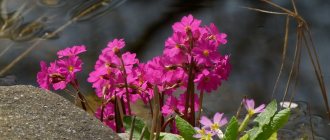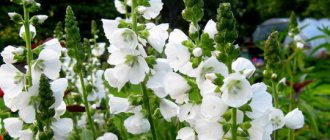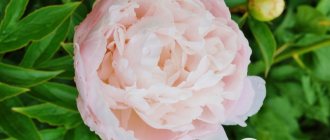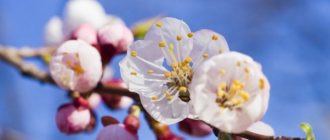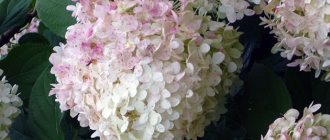Summer residents and owners of private houses love to grow peonies in their garden plots. They are fabulously beautiful and easy to care for. Thanks to the diversity of species, you can create beautiful color combinations in flower beds.
With the correct selection of planting material, you can admire flowering plants for a long period. Breeders have developed many varieties of peonies, but some of them are especially popular and loved by flower growers.
General description of peonies
Peonies are herbaceous perennial or deciduous shrubs. The plants are small, up to 1 m in height, with straight stems, forming a lush bush. The underground organ is rhizomes with large thickenings.
The leaves are pointed, deeply dissected, smooth, with their leathery, juicy dark green surface, indicating the semi-tropical origin of the plant. The buds are beautiful, memorable, almost perfectly round in shape. Large flowers with silky outer petals and a beautiful center bloom from the buds.
Classification of peonies
The simplest classification divides peonies into two groups: tree-like and herbaceous.
By groups
Tree-like:
- European.
- Japanese.
- Hybrids of yellow peony and Delaway peony.
Herbaceous:
- Narrow-leaved.
- Evasive.
- Drug.
- Milky-flowered.
- Mlokosevich.
ITO hybrids are also distinguished separately. This is the result of crossing tree and herbaceous plants.
For the convenience of gardeners, the crop is classified according to the type of flower and flowering time.
Varieties of peonies by flower type
- Terry ones are the most lush. They look like an almost perfect sphere. The stamens of these peonies have turned into full-fledged petals. There are varieties in which stamens and pistils are completely absent, while in others they are hidden by petals.
- Semi-double have 5 or more large petals, stamens are present, but they look like narrow petals, which alternate with stamens that have completely lost their original appearance - they look like ordinary petals. These varieties are similar to terry ones, but lighter and the outer “border” of large petals is clearly visible.
- Simple or non-double peonies. These varieties have only 5-10 petals, located along the edge of a wide center, which is quite decorative due to the abundance of large stamens. The stems are easy to cut, straight and stable.
- Anemone-shaped - flowers with large silk petals, from 5 pcs., and a remarkable center. The stamens lost their anthers and took on the appearance of narrow petals (staminodes). The pistils are well developed, but they are not visible.
- Japanese - are an intermediate type between simple and terry. The stamens of this group have changed and look like narrow petals. The petals can be straight or slightly curly, like those of a chrysanthemum. The stems are straight and stand well when cut.
Lyubov Aristarkhova
Owner of the Peony Paradise collection garden, candidate member of the Moscow Flower Growers club, member of the Peonies of Russia community
“Very often the Japanese and anemone groups are confused. But it is not difficult to distinguish them. In anemone-like peonies, the staminodes are wider and more pronounced, they are collected into a dense cushion and stand out strongly against the background of the outer petals. "Japanese peonies have less contrast and can sometimes look like double peonies if the staminodes are the same color as the outer petals."
Classification of varieties by flowering period
According to flowering dates, they are distinguished:
- Very early - bloom in May, until the first ten days of June.
- Early varieties of peonies bloom en masse in the second half of the first ten days of June, from the 5th to the 10th.
- Mid-early - bloom from June 10 to 15.
- Medium peonies bloom from June 15 to June 20.
- Mid-late – from June 20 to 25.
- Late peonies decorate flower beds from June 25 until the end of the month.
- Very late - early July.
In the description, a variety will not always belong to an exact group; in practice, some of them are often combined. For example, very early ones are considered early.
Below we describe the most popular varieties, which are most often mentioned on specialized forums and are regularly included in selections of the best peonies.
Features of cultivation
Ito hybrids are represented by unpretentious frost-resistant varieties that a novice, inexperienced gardener can grow. They are pleasing to the eye, complement mixborder compositions, and are also used to create monochrome flower beds.
Expert opinion
Zarechny Maxim Valerievich
Agronomist with 12 years of experience. Our best country expert.
Ask a Question
Information! Ito peonies are usually propagated by dividing the bush, cuttings, or planting seeds.
Root cuttings
The first question that faces a gardener who decides to grow Ito-hybrid varieties of peonies concerns the method of planting them. Root cuttings are a variant of breeding hybrids, in which part of the rhizome with one root and a growth eye is used for planting.
Reference! Parts of the rhizome that remain after dividing the bush are suitable for root cuttings.
Cuttings begin in July-August. After being cut off from the main root, root cuttings must be disinfected by prolonged soaking in a manganese solution. Then the dried cuttings are rolled in charcoal so that a crust forms on the root. This helps protect the plant from soil infections.
After treatment, the root cutting is planted on loose, nutritious soil. Rooted cuttings must be additionally shaded so that they are not damaged by direct sunlight. After two seasons, the rooted cuttings are transplanted to a permanent place of growth.
Seeds
Common herbaceous peonies are planted from seeds, despite the fact that the growing process takes a long time. As for Ito hybrids, their seeds are difficult to find. In addition, planting seeds does not guarantee that the flower that is stated on the package will grow in the flowerbed. When planting from seeds, the color of the petals may change. At each stage of growth, irreversible changes occur to the bush.
When planting seeds, the seedling-greenhouse method is used. First, the seedlings are grown to 15-20 centimeters, then they begin planting in areas of open ground. It may take 2-3 years to grow seedlings.
Herbaceous peonies
Most modern varieties of peonies, about 4,500 varieties, belong to the herbaceous group. Popular types with names and photos.
Bridle Shower
A mid-early variety, with a bush up to 1 m high. The flowers are single, white with a creamy, very fluffy center, up to 20 cm in diameter, the outer petals are arranged in two rows. Each stem has 4 buds. There is a light, pleasant aroma.
In memory of Gagarin
Double pink-white flower up to 18 cm in diameter. Red splashes are visible on individual petals. Height up to 80 cm. Blooms in mid-season.
Sarah Bernhardt
The classic comes from France. The flowers are lush, double, pink-shaped, elegant, pink with a lilac tint. The diameter of the flowers is up to 20 cm. The bush is up to 95 cm. It blooms late.
Red Grace
An old proven early variety with small openwork green foliage and magnificent, flawless round double flowers up to 18 cm in diameter of a bright red-cherry color. The general neatness and stateliness attracts attention.
Henry Boxtos
The bush is up to 90 cm high, the flowers are densely double, similar to huge roses, up to 22 cm in diameter, of an intense dark red color. There is 1 flower on 1 shoot, but they are very dense, even in full bloom the flower is dense. Early variety.
Tree peonies
There are about 500 tree varieties. A few of the most interesting:
Blue sapphire
The flowers are lush, delicate, up to 18 cm, there are bright purple splashes in the center of the petals, the stamens are bright yellow. Because of the range of colors, the flower looks exotic. Bush - up to 120 cm.
spring willow
A rare species, intriguing with its large green-yellow balls of flowers, up to 18 cm in diameter. Bushes up to 1.5 m.
Kiao Sisters
The flowers are contrasting and dramatic, with white and bright crimson segments. Not too large for a peony - up to 15 cm, but numerous. Height – up to 150 cm.
White jade
An ancient variety with delightful white flowers up to 17 cm. The petals are large, elegantly framed by a small yellow center. It has a very delicate aroma and a luminous shade of flowers. Bush - up to 170 cm.
Green ball
In full bloom, this peony has pink flowers; at the beginning of bloom, they are light green. The flowers are densely double, large, up to 20 cm in diameter. Bush - up to 1.5 m.
From the photos and names of tree peonies it is noticeable that they are very different from herbaceous varieties. More refined, authentic, with Asian flavor. And the plants themselves are radically different: tree-like ones do not die off in the winter; taller ones, with strong branches, can grow in one place for up to 50 years.
Is it better to cut off faded peonies or leave them?
Lyubov Aristarkhova
Owner of the Peony Paradise collection garden, candidate member of the Moscow Flower Growers club, member of the Peonies of Russia community
When the peony has bloomed, everything that has dried out must be torn off. Peduncles can be cut back to the top leaf. The plant will not have an untidy appearance. Decorative greenery will remain. Also, faded inflorescences will not take over the strength of the plant. You cannot cut off faded peonies at the root, as this will greatly weaken the bush. The foliage feeds the root as long as there is at least some green color in it. Leaves can be removed completely only in the fall, when they wither, dry out and fall to the ground.
Necessary crop care
Planting and growing Ito hybrids is a process associated with constant control over the condition of the plant. Violations of the rules of care can lead to death or the development of diseases.
Watering and fertilizing
Watering is an important part of care. In the spring, plants are shed with a manganese solution to disinfect the soil. Then set a watering schedule. During the period of active growth and flower formation, bushes need a constant supply of moisture. Each bush is watered weekly in a specially dug furrow a few centimeters from the main stem. For each adult bush you will need 1-2 buckets of warm water. The soil around the plant must be kept moist, this is due to the structural features of the root system.
After flowering begins on the bush, watering is reduced. After flowering, a new stage begins when the soil must be constantly moistened. The bud formation of the next season depends on compliance with this rule.
Feeding is divided into several stages:
- Spring. Spilling manganese solution.
- Summer. Before flowering, superphosphate and potassium sulfate are added.
- Monthly. Application of mineral foliar mixtures.
- Pre-winter. Feeding using mineral compounds.
Mulching and loosening the soil
Peonies do not tolerate weeds growing near the stem. The root system of peonies, which is located at a distance from the main stem, needs a lot of free space; they cannot share it with other plants. Loosening the soil solves the problem of weed growth, while at the same time saturating the soil with oxygen, making it looser and lighter.
Mulching peonies solves several problems:
- protects against weeds;
- retains moisture;
- keeps warm;
- Helps protect against diseases and pest attacks.
Attention! For mulching, use pine bark, needles or freshly cut grass. If the grass begins to actively rot, the layer of mulch must be replaced.
See also
Description of Byzantine gladiolus, planting and caring for the variety in open ground
Read
Treatment against pests and diseases
Tight, unopened buds often attract various pests. Aphids, bronzes, thrips - this is an incomplete list of peony lovers. They are destroyed using common insecticides or using proven folk remedies.
Peony bushes are especially loved by ants. The sweet syrup that the unopened bud secretes attracts ants, and they settle on the entire surface of the flower. One of the control options is to pour boiling water over the anthill, which is located near the bush.
Attention! Flower growers recommend treating peony bushes from pests in advance. Foliar treatment, which involves spraying with various infusions and solutions, helps well.
Preventive measures that are carried out in spring and autumn protect against diseases.
Transfer
The best time to plant or replant a peony bush is the second half of August or the first half of September. At this time, the plants are going through a dormant period, so all procedures will be painless. The dates can be shifted at your discretion, but it is important to comply with the main requirement - the cuttings must take root before the onset of frost.
Trimming
Pruning on the bush is carried out only when buds have successfully set after flowering. If you prune very early, the bush will not be able to form buds the next season. Ito hybrids are usually pruned only in the third year after the first flowering. The bush is cut to 15-20 centimeters, then mulched and covered for the winter. As for the removal of faded buds, it must be timely. Removing faded flowers will encourage further flowering.
Preparing for winter
The main technique for preparing Ito-peony bushes for winter is mulching. The soil is covered in such a way that the roots of the bush, located almost horizontally, are covered with a layer of mulch 10 centimeters thick. For mulch, you should use a soil mixture that will not change the acidity level.
In winter, despite the frost resistance of Ito varieties, it is necessary to additionally cover the bushes with non-woven material or special materials for the garden. This condition especially applies to young peony bushes that are not pruned.
Japanese peonies
There are not very many Japanese peonies. The most interesting varieties of Japanese peonies with names and photos:
- Easy Lavender - pink-lavender bright petals and the same center.
- Rheingold - white outer petals, bright yellow center. The petals in the center are thick,
quite thick. - Golden Bracelet is an interesting variety not only in itself, but also because it belongs to the double crowned Japanese varieties; it is an intermediate variety in this group. The variety has several rows of large white petals, the staminodes are soft gold, and a high center in which white, but narrower petals are visible again. The flower looks like an exotic chrysanthemum.
- White Sands. It is sometimes classified as an anemone group. The flowers are white, with a yellow center, and lush.
- Neon is an original flower of bright lilac-pink color. The staminodes have the same color, but there is a nuance - each of them has a very bright contrasting golden-yellow edge, as if each petal was outlined with a pencil.
Japanese varieties tend to be very aromatic. The aroma can have fruity or oriental shades.
Use in garden design
With their lush and bright blooms, peonies attract attention and are a bright accent of the garden composition. Bushes are planted in groups or individually:
- on the lawn;
- form an elongated flower bed along the path;
- planted in the front area, at the entrance to the house.
In mixed flower beds, the peony plays the main role; its neighbors can be plants with decorative foliage, conifers and flowers that bloom after the main soloist of the flowerbed, the peony, has bloomed.
What to plant next to is the best option when there is nothing nearby except grass or lawn. Depending on the color of the flower, you can place nearby - hellebores, barberries, ornamental greens, sage, daylily, poppy, bells, honeysuckle.
More examples of successful peony neighbors: cereals, geranium, white tansy, sedum, iris, delphinium, thuja, juniper.
Ito hybrids
A very popular variety because it combines the power of trees and the lightness of herbaceous ones.
Border Charm
Yellow double flowers up to 16 cm in diameter, bush up to 70 cm. There are scarlet strokes at the base of the petals. In selections of varieties of yellow peonies, the names Barzella, Sunny Boy, and Gold Mine are often mentioned.
In the photo these are more lush flowers, but they are all herbaceous, Border Charm is more hardy and exotic.
Cora Louise
Very large flowers up to 25 cm, tall bushes up to 90 cm. The flowers are pale lilac with an extremely bright violet-burgundy center. Contrasting, bright variety.
Cannery Diamonds
Flowers of complex but popular colors, coral varieties of peonies are in fashion. This variety has semi-double flowers up to 20 cm in diameter, variable colors, combining yellow, apricot, and pink tones. Bush – 90 cm.
Lollipop
Exotic flowers up to 17 cm, double, bush - 85 cm. Flowers of outstanding color - fuchsia-colored splashes spread in rivulets over a light yellow background.
Hilary
Double flowers up to 17 cm, even closer to true coral. Color changeable. The warm pink tone can transition into lighter creamy tones and almost cherry. Bush – 90 cm.
Tree peonies die off in the winter, so they winter well in the Russian climate.
Diseases, pests and treatment
Peonies are very hardy and unpretentious plants. Indoor peonies practically do not get sick provided they are properly cared for - bright lighting, watering three times every ten days and a sand-based substrate.
Garden peonies are most often affected by fungal diseases such as gray mold, rust, phyllosticosis, powdery mildew, septoria, root rot and cladosporiosis. To prevent the occurrence of fungal infections in peonies, you should follow the rules of watering and treat places of cuts, breaks and any mechanical damage with tree resin or activated carbon.
If the first signs of fungal infection are noticed on a peony bush, then in order not to lose the bush and not infect neighboring plants, you should immediately begin treatment. Bushes affected by the fungus are treated with a fungicide, with the preliminary removal of all infected parts of the plant.
When growing peonies, you can also encounter viral infections. It will not be possible to cure the bush from them, so it will have to be completely uprooted and burned. The pit in which the peony was located must be disinfected.
Insects can also encroach on beautiful peony bushes. The main pests of this plant include: aphids, all types of nematodes, ants, bronze beetles and fine hop borers. You can get rid of insects by treating the bushes with insecticides. However, larvae can be deposited in the ground next to the peony bush, so the top layer of soil should be removed and the soil around the peony should be treated.
Two-color peonies
Exotic colors in modern varieties of peonies are not uncommon. What adds spice is that color combinations can be played out in different ways. These can be stains, strokes, stripes, spots, differently colored petals.
Peaches and Cream
There is a variety with a similar name - Peach and Cream. But the Peaches and Cream variety has different flowers - they look like a dessert of fruit and ice cream.
The coloring magically combines cream, pink and peach tones. Flower – 14 cm, bush – 90 cm.
Kirinmaru
A ball of white petals with thin crimson stripes, like streams. Flower – 15 cm. Bush – 80 cm.
Raggedy Ann
Still a rare variety. Large flower 16 cm with huge numerous pistils. The petals are soft pinkish-white with blueberry-purple spots at the base. The strongly jagged edge of the petals adds piquancy. Bush – 70 cm.
Raspberry Sunday
Balls of amazing colors, pink at the bottom, vanilla in the middle, pink-raspberry on top. The colors are very delicate, filling, and the boundaries between the stripes are clearly visible. Flowers – 18 cm, bush – 70 cm.
Julia Rose
The flower is semi-double, large, silky, gradually changing color from cherry-red to apricot and then yellow. The coloring is watercolor, sometimes the flower looks like it has a border, but mostly the stains are irregular. Flower – 18 cm. Bush – 90 cm.

